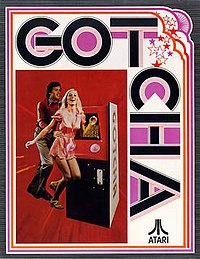Gotcha (arcade game)
| Gotcha | |
|---|---|

Advertising flyer for the game, featuring the original cabinet design
|
|
| Developer(s) | Atari |
| Publisher(s) | Atari |
| Designer(s) | Allan Alcorn |
| Platform(s) | Arcade |
| Release | October 1973 |
| Genre(s) | Maze |
| Mode(s) | Multiplayer |
| Cabinet | Upright |
| CPU | Discrete |
| Sound | Monaural |
| Display | Horizontal orientation, black and white raster display |
Gotcha is an arcade game developed by Atari and released in October 1973. It was the fourth game by the company, after the 1972 Pong, which marked the beginning of the commercial video game industry, and the 1973 Space Race and Pong Doubles. In the game, two players move through a maze, which continually changes over time. One player, the Pursuer, attempts to catch the other, the Pursued; if they do, a point is scored, and the players reset positions. The game emits an electronic beeping sound, which increases in pace as the Pursuer gets closer to the Pursued, and each game lasts a set amount of time.
Gotcha was designed by Allan Alcorn, the designer of Pong, and a prototype was constructed by Cyan Engineering, Atari's semi-independent research and development subsidiary. Development began in July 1973 as part of Atari's strategy to develop multiple types of games to separate themselves from their competitors, who they saw as focused primarily on creating Pong clones. The cabinet was designed by George Faraco, initially with the joysticks encased in pink domes meant to represent breasts. Although this design inspired the advertising flyer on which it appears behind a man chasing a woman in a nightdress, it was changed to use regular joysticks soon after release.
The game was not commercially successful; later sources have termed it as "arousing little more than controversy", though one source claims it sold 3,000 units. In addition to the main black-and-white game, limited runs were produced of a tinted color version and a true multi-color version of the game; the latter is believed to be the first color arcade game. Gotcha inspired an enhanced version featuring cops and robbers titled Maze Craze for the Atari 2600 in 1977, which was more popular than the original.
Gotcha is a two-player maze game in which one player attempts to catch the other. The maze is composed of a repeating pattern of elements set in multiple columns on the screen. The "Pursuer" is represented by a square, while the "Pursued" is identified by a plus sign. As the Pursuer gets closer to the Pursued, an electronic beeping sound plays at an increasing rate until the Pursuer reaches the Pursued. Whenever the Pursued is caught, the Pursuer scores a point, the maze disappears for a brief moment, and the Pursuer is moved to a random position on the right side of the screen. The maze itself is continually changing, with two invisible lines half a screen apart scanning down the maze and overwriting maze elements. Above the maze is the Pursuer's score and the time elapsed in the game. Each game is for a set period of time. When time runs out, the game enters attract mode, where the score resets and the square and plus sign begin bouncing around the maze in a diagonal pattern as the maze continues to change. Each game costs a quarter. The time per round is adjustable per machine over a range from 30 seconds to 2 minutes.
...
Wikipedia
